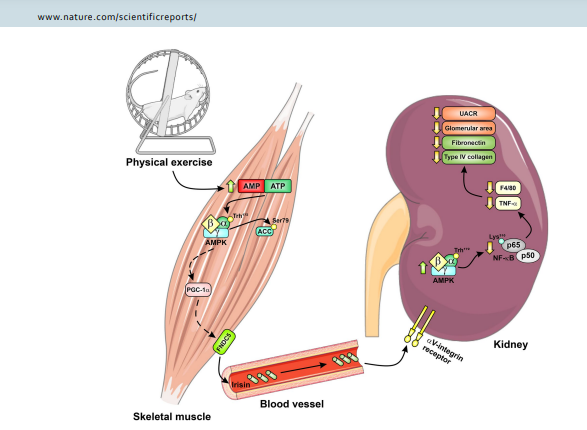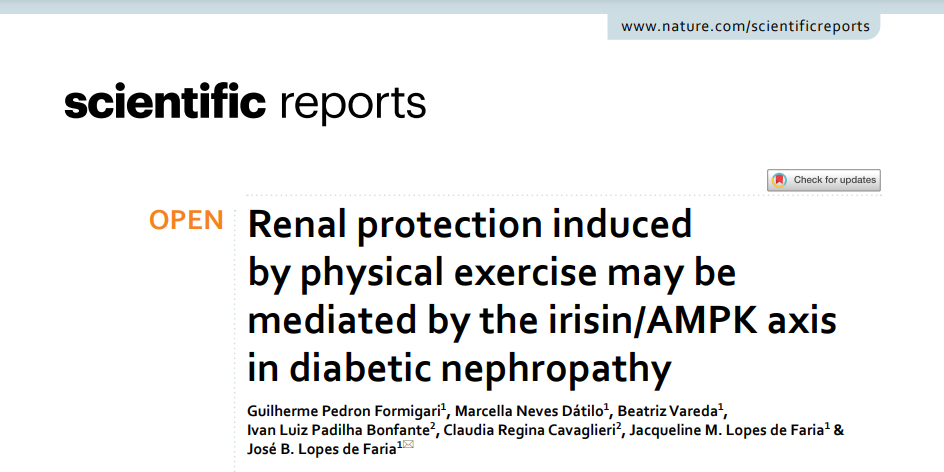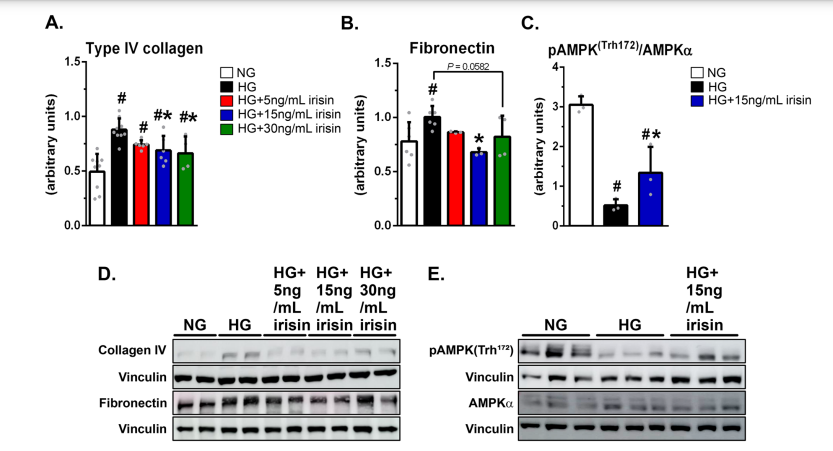Site editor:
Joaquim Cardoso MSc.
The Health Strategist — research, strategy and implementation
September 25, 2022
Agencia Fapesp
Mônica Tarantino
19 de setembro de 2022
Key messages:
- Constatação foi feita por pesquisadores da Unicamp por meio de experimentos com ratos e cultura de células renais humanas.
- Scientific Reports mostram que a irisina, substância liberada durante a prática de atividade física, evita a degeneração celular que leva à nefropatia diabética e à insuficiência renal
- Liberada pelo tecido muscular durante a prática de atividade física, a irisina é a mais recente esperança dos cientistas para proteger os rins de pessoas diabéticas dos danos causados pela progressão da doença.
- A substância, também conhecida como hormônio do exercício, é considerada pelos cientistas como um dos principais mensageiros químicos responsáveis pela longa lista de benefícios proporcionados pela atividade física regular ao organismo humano.

Após uma sequência de experimentos, um grupo de pesquisadores da Universidade Estadual de Campinas (Unicamp) não apenas confirmou os benefícios da substância aos rins como descreveu, pela primeira vez, de que maneira ela pode prevenir os estragos renais produzidos pelo diabetes.
Silenciosa, a doença atinge entre 20% e 40% dos diabéticos. Ao provocar danos nos vasos sanguíneos, artérias e veias que irrigam os rins, conduz à insuficiência renal crônica.
Silenciosa, a doença atinge entre 20% e 40% dos diabéticos. Ao provocar danos nos vasos sanguíneos, artérias e veias que irrigam os rins, conduz à insuficiência renal crônica.
“Nós constatamos que o exercício aeróbico está associado a um aumento da irisina muscular na circulação sanguínea e também nos rins, conferindo nefroproteção”, explica o médico José Butori Lopes de Faria, do Laboratório de Fisiopatologia Renal e Complicações do Diabetes da Faculdade de Ciências Médicas (FCM-Unicamp) e orientador de Guilherme Pedron Formigari, primeiro autor do estudo.
O trabalho, publicado na revista Scientific Reports, teve apoio da FAPESP.

Metodologia
O primeiro passo dos pesquisadores foi induzir o diabetes em ratos com oito semanas de idade e medir indicadores de danos renais, como a presença de albumina na urina.
A perda dessa proteína é sinal de que as células renais já começaram a sofrer os efeitos do diabetes.
Os animais foram separados em três grupos — controle, diabéticos sedentários e diabéticos exercitados (submetidos a treinamento físico em esteira rolante por oito semanas).
“Vimos que o exercício aeróbico está associado ao aumento da irisina no tecido muscular e na circulação sanguínea, bem como ao aumento da enzima AMPK [proteína quinase ativada por monofosfato de adenosina, que atua como sensor metabólico das células] nos rins, conferindo nefroproteção”, disse Faria.
Na segunda etapa, a equipe injetou medicamentos nos roedores diabéticos e exercitados para bloquear a ação renal da irisina.
A deficiência da substância coincidiu com o bloqueio dos efeitos benéficos do exercício, como a redução de albumina na urina e a menor expressão de substâncias que atuam na fibrose dos glomérulos (a unidade do rim que faz a filtragem do sangue e a eliminação dos resíduos do metabolismo).
“A falta da irisina aboliu os efeitos protetores do exercício ao rim diabético”, escreveram os pesquisadores.
Mais uma prova foi feita com células tubulares renais humanas cultivadas em laboratório para saber se o tratamento com irisina seria capaz de evitar as alterações da glicose elevada.
Durante o processo de filtragem feito pelos rins, os túbulos renais reabsorvem e devolvem ao sangue a água, eletrólitos e nutrientes necessários.
No teste, eles foram imersos em um meio que simulava as condições do diabetes e continha o hormônio na sua forma recombinante, fabricada pela indústria.
“A resposta foi positiva. Concluímos que o exercício físico aumenta a irisina no músculo e na circulação e que, nos rins, a presença desse hormônio ativa a enzima AMPK, que bloqueia os mecanismos da fibrose renal”, explica Faria.
Concluímos que o exercício físico aumenta a irisina no músculo e na circulação e que, nos rins, a presença desse hormônio ativa a enzima AMPK, que bloqueia os mecanismos da fibrose renal

Em projeto anterior, também apoiado pela FAPESP, o nefrologista havia demonstrado o papel da enzima AMPK na fibrose renal, que resulta de um estado de inflamação crônica das células e faz com que percam sua função.
Neste novo trabalho, os pesquisadores avaliaram o soro humano (sangue centrifugado, sem os glóbulos vermelhos) de diabéticos exercitados e sedentários.
Nas amostras de quem se manteve em atividade, a irisina encontrada protegeu o rim e reduziu a lesão das células tubulares expostas a alta concentração de glicose.
“Pela primeira vez, podemos afirmar que, no diabetes, o eixo irisina/AMPK induzido pelo exercício físico protege as células renais dos efeitos da alta glicose”, concluíram os autores.
“Pela primeira vez, podemos afirmar que, no diabetes, o eixo irisina/AMPK induzido pelo exercício físico protege as células renais dos efeitos da alta glicose”, …

Identificada por biólogos da Universidade de Harvard (Estados Unidos) há uma década, a irisina tem sido alvo de muitos estudos que visam desvendar seus mecanismos de ação.
Pesquisas com roedores já mostraram, por exemplo, que esse hormônio também é importante para a formação da memória e a proteção dos neurônios em roedores com enfermidade semelhante ao Alzheimer, entre outros benefícios
Pesquisas com roedores já mostraram, por exemplo, que esse hormônio também é importante para a formação da memória e a proteção dos neurônios em roedores com enfermidade semelhante ao Alzheimer, entre outros benefícios.
( leia mais em: revistapesquisa.fapesp.br/hormonio-do-exercicio-pode-evitar-a-perda-de-memoria/).
Originally published at https://agencia.fapesp.br.
( imagem: acervo dos pesquisadores)
REFERENCE PUBLICATION

Renal protection induced by physical exercise may be mediated by the irisin/AMPK axis in diabetic nephropathy
Scientific Reports
Guilherme Pedron Formigari,
Marcella Neves Dátilo,
Beatriz Vareda,
Ivan Luiz Padilha Bonfante,
Claudia Regina Cavaglieri,
Jacqueline M. Lopes de Faria &
José B. Lopes de Faria
Abstract:
- In patients with diabetes, it has been suggested that physical exercise may reduce albuminuria and the progression of renal disease.
- However, the molecular mechanism by which physical exercise protects the kidney in diabetes remains poorly understood.
- The aim of the present study was to determine the contribution of muscle irisin secretion induced by aerobic physical exercise with the subsequent activation of AMPK for kidney protection under diabetic conditions.
- Aerobic physical exercise in rats protected the kidney in streptozotocin-induced diabetes.
- It reduced albuminuria, glomerular hypertrophy, and glomerular expression of collagen IV and fbronectin, as well as markers of kidney infammation, when compared to sedentary diabetic rats.
- These efects were associated with elevation in muscle FNDC5/irisin and activity of AMPK in the diabetic kidney.
- However, the benefcial efects of exercise were lost when the diabetic rats were treated with CycloRGDyK, that in the bone it has been described as an irisin receptor blocker.
- In cultured human tubular (HK-2) cells, treatment with recombinant irisin counteracted the effect of high glucose in a dose-dependent manner. Irisin, per se, also activated AMPK in HK-2 cells.
- It is concluded that in diabetes, the renal protective efect of exercise may be mediated by the irisin/AMPK pathway
It is concluded that in diabetes, the renal protective efect of exercise may be mediated by the irisin/AMPK pathway
Introduction [excerpted]
Despite considerable advances in the management of diabetic nephropathy, it remains the main cause of end-stage renal failure in most parts of the world 1 .
Therefore, new strategies for the treatment and prevention of this serious complication of diabetes mellitus (DM) are urgently needed.
Physical exercise may be beneficial for the prevention and treatment of a wide variety of chronic diseases, …
… including, but not restricted to, cardiovascular disease, diabetes, hypertension, and certain types of cancer 2 .
In chronic kidney disease (CKD), it has been suggested that physical exercise may improve renal function, although no definitive study has shown that physical exercise can slow the progression of renal function in CKD patients3 .
In type 1 diabetic subjects, intense physical activity is associated with the prevention of the development of microalbuminuria, as well as a reduction in the progression of nephropathy4 .
In experimental diabetic nephropathy, a nephroprotective efects of aerobic physical exercise has been demonstrated 5 .
Physical exercise may be beneficial for the prevention and treatment of a wide variety of chronic diseases, …
However, the molecular mechanism behind this protection remains poorly understood.
However, the molecular mechanism behind this protection remains poorly understood.
Irisin is a myokine secreted by skeletal muscle in response to exercise 6 .
Importantly, a recent study identifed the αV class integrins as the receptor of irisin in bone7 .
It has been suggested that this muscle-derived circulating factor could be the link between physical exercise and organ protection6 .
Indeed, irisin may mediate the effects of physical exercise in rescuing synaptic plasticity and memory in models of Alzheimer’s8 .
In another study, it was found that in the kidney, fbrosis was diminished by irisin, and this efect was mediated by the inhibition of the transforming growth factor (TGF) receptor β type 19 .
Thus, the authors of that study concluded that irisin mediated crosstalk between the muscle and the kidney to reduce kidney fbrosis9 .
Tat irisin has nephroprotective action has also been shown in the animal model of acute kidney injury (AKI), namely the ischemia/reperfusion (I/R) model10,11.
In these reports, it was suggested that irisin protects the kidney by reducing tubular cell death via p5311 and increasing UCP2 with consequent reduction in apoptosis10.
In nondiabetic12,13 and diabetic14 subjects, cross-sectional studies have shown an association between lower plasma levels of irisin and CKD.
However, the observations of these studies do not allow us to establish a causal link between plasma irisin levels and CKD.
Irisin is a myokine secreted by skeletal muscle in response to exercise. It has been suggested that this muscle-derived circulating factor could be the link between physical exercise and organ protection6 .
The possible contribution of irisin to the induction of kidney protection through exercise in diabetes has not yet been investigated.
Activation of AMP kinase (AMPK) is a potential strategy for treating diabetic nephropathy15.
Irisin may be able to activate AMPK in vitro in myoblasts exposed to high glucose16 and in human microvascular endothelial cells treated with bacterial lipopolysaccharides (LPS)17.
In vivo, it has been demonstrated that irisin stimulates the activity of AMPK in the I/R model of AKI11.
However, the role of irisin in the activation of kidney AMPK under diabetic conditions remains elusive.
In this study, we sought to determine the contribution of muscle irisin secretion induced by aerobic physical exercise with the subsequent activation of AMPK for kidney protection under diabetic conditions.
The possible contribution of irisin to the induction of kidney protection through exercise in diabetes has not yet been investigated.
In this study, we sought to determine the contribution of muscle irisin secretion induced by aerobic physical exercise with the subsequent activation of AMPK for kidney protection under diabetic conditions.
Other sections
See the original publication
Discussion [excerpted]
Here, we demonstrated that in experimental diabetes, a program of aerobic physical exercise confers nephroprotection and is associated with elevation in muscle and serum irisin, concomitant with elevation in kidney AMPK activity.
Furthermore, our in vivo observation that blocking the irisin receptor abolished the protective efects of exercise in the diabetic kidney suggests that irisin might play a crucial role in nephroprotection.
This statement is corroborated by the observation of a signifcant inverse correlation between the muscle expression of FNDC5-irisin and albuminuria, on the one hand, and between FNDC5-irisin and the glomerular expression of fbronectin and NFkB, on the other (Fig. 2J–L).
In vitro, recombinant irisin, per se, prevented the efects of HG on ECM accumulation in HK-2 cells in a dose-dependent manner.
These efects of irisin were accompanied by the activation of AMPK.
Finally, serum from exercised diabetic subjects, but not from sedentary diabetic individuals, could prevent the HG efect of elevating ECM components in HK-2 cells.
This result allows us to suggest, to the best of our knowledge for the frst time, that in diabetes, irisin/AMPK axis may mediate the kidney protection induced by physical exercise.
This result allows us to suggest, to the best of our knowledge for the frst time, that in diabetes, irisin/AMPK axis may mediate the kidney protection induced by physical exercise.
In Fig. 6, we summarize a possible sequence of events that may determine kidney protection through physical exercise in diabetes.
Figure 6. Schematic representation of the mechanism by which irisin/AMPK may mediate the role of physical exercise in inducing renal protection in diabetes. Interrup

In diabetic nephropathy, blood glucose and blood pressure control are important factors in the development and progression of the disease 18.
Thus, it is important to note that in the current study, with diabetic rats, physical exercise did not modify blood glucose levels, but it did reduce systolic blood pressure (BP).
Therefore, we cannot exclude the possibility that a reduction in systolic BP contributed to the nephroprotection promoted by exercise.
It is unclear whether the elevation of irisin by physical exercise contributed to the reduction in BP, although recent data suggest that irisin may reduce BP.
Indeed, the acute administration of irisin to spontaneously hypertensive rats has been shown to reduce BP19.
Interestingly, in this last study, it was suggested that the reduction of BP requires the activation of AMPK because the use of compound C, an AMPK blocker, abolished the efect of irisin on reducing BP.
Glomerular ECM accumulation is a hallmark of diabetic nephropathy 20.
In the present study, physical exercise in diabetic rats reduced the expression of markers of ECM in the glomerular area.
Crucially, the effect of physical exercise on reducing glomerular ECM accumulation was lost when diabetic rats were treated with an irisin blocker, the alfa V integrin receptor blocker7 .
In addition, in an in vitro model of diabetic nephropathy, where HK-2 cells were treated with HG, irisin per se inhibited the elevation of the ECM components increased by HG.
This piece of data suggests that irisin may play a role in nephroprotection in diabetes.
This piece of data suggests that irisin may play a role in nephroprotection in diabetes.
As expected, in our study, physical exercise activated skeletal muscle AMPK (Fig. 2F–H).
It is likely that this was due to a decrease in ATP levels with consequent elevation in the AMP/ATP ratio (Fig. 2I).
This then led to the binding of AMP to the regulatory gamma subunit, allosterically activating AMPK.
In our diabetic rats, physical exercise was also associated with an elevation in renal AMPK activity.
The mechanism by which physical exercise activates renal AMPK is not apparent. However, we speculate that renal AMPK might have been activated by irisin following its binding to a still unidentifed renal receptor.
Irisin’s ability to activate AMPK has already been suggested under diferent conditions16,17,21.
In addition, we observed that irisin per se was able to activate AMPK in HK-2 cells under diabetic conditions (Fig. 4C, E).
Therefore, it is plausible that the activation of kidney AMPK contributes to nephroprotection. However, this hypothesis merits further studies for confirmation.
Therefore, it is plausible that the activation of kidney AMPK contributes to nephroprotection. However, this hypothesis merits further studies for confirmation.

Figure 4. Irisin treatment reduces extracellular matrix accumulation and activates AMPK in HK-2 cells exposed to high glucose.
(D, E) Western blot analysis of type IV collagen, fbronectin, and vinculin (D) and pAMPK(Tr172), AMPKα (E) in HK-2 cells, followed by quantitation of collagen IV/vinculin (A), fbronectin/ vinculin (B), and pAMPK(Tr172)/vinculin by AMPKα/vinculin ratio ©
We have assessed the pACC, a downstream of AMPK, as further evidence of AMPK activation 22.
Because pACC was neither diminished nor elevated in the kidneys of diabetic rats, we cannot claim that pACC is involved in the renal protection induced by exercise.
Because pACC was neither diminished nor elevated in the kidneys of diabetic rats, we cannot claim that pACC is involved in the renal protection induced by exercise.
Although there are good experimental data suggesting that irisin may protect diferent organs 8,9,21, the same does not apply to humans.
Our observation that serum from exercised diabetic subjects, who had elevated serum irisin compared to sedentary diabetic subjects, was able to counteract the efect of high glucose in HEK-2 cells is an interesting one.
However, this must be interpreted with caution.
Physical exercise can modulate many proteins in the serum, and we have not proven that the benefcial efect of exercise was indeed due to irisin.
The question of whether physical exercise may protect the kidney via irisin in diabetic subjects remains open for further investigation.

In sum, our data suggest that in diabetes, renal protection induced by physical exercise may be mediated by irisin/AMPK axis.
Further studies using other models of experimental diabetes, probably with the addition of knockout mice, are needed to confirm this original hypothesis. This hypothesis should also be tested in humans.
In sum, our data suggest that in diabetes, renal protection induced by physical exercise may be mediated by irisin/AMPK axis.
Further studies using other models of experimental diabetes, probably with the addition of knockout mice, are needed to confirm this original hypothesis. This hypothesis should also be tested in humans.
About the authors & affiliations:
Guilherme Pedron Formigari 1 , Marcella Neves Dátilo 1 , BeatrizVareda1 , Ivan Luiz Padilha Bonfante2 , Claudia Regina Cavaglieri2 , Jacqueline M. Lopes de Faria1 & José B. Lopes de Faria1*
1 Renal Pathophysiology Laboratory, Investigation On Diabetes Complications,
State University of Campinas (UNICAMP),
2 Laboratory of Exercise Physiology, School of Physical Education, State University of Campinas (UNICAMP), Campinas, SP, Brazil.
References and additional information
See the original publication
O artigo Renal protection induced by physical exercise may be mediated by the irisin/AMPK axis in diabetic nephropathy pode ser lido em: www.nature.com/articles/s41598-022-13054-y#Ack1.












